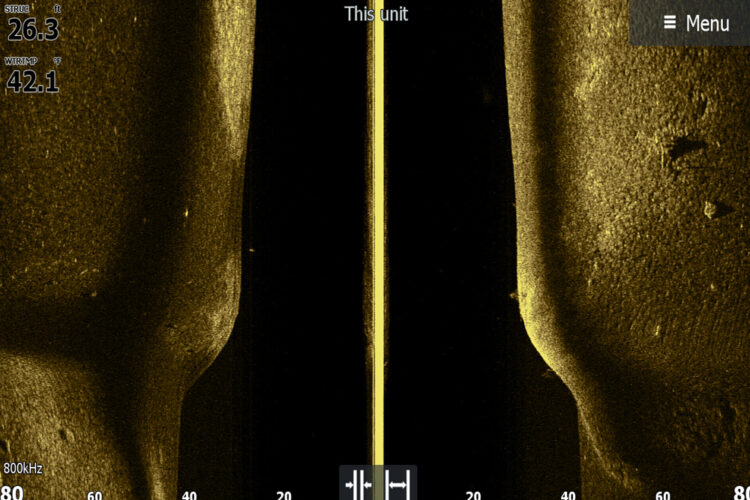Side imaging is the hardest of all sonar technology to decipher for most anglers. (photo Brad Wiegmann)
Catch More Fish with Side Imaging Sonar
by Brad Wiegmann
Has live sonar made side imaging sonar obsolete? No, but it has changed when and where anglers are now using it. Truth is tournament anglers may be using it even more to find areas to fish with live-imaging sonar.
Side imaging sonar relies on ultra-thin beam from a transducer that scans a small slice of the boat side-to-side. This return image is a lifelike, snapshot to the right and left of your boat’s location. The imaging continues and adds up to a detailed view of the bottom of the lake. In other words, trees look like tress, boulders look like boulders and bottom terrain like bottom terrain.
Unlike other sonar technologies side imagine displays differently from the other sonar imaging. A dark, center section is shown directly under the boat and represents the water column from the bottom of the boat to below. On the left and right side is a “fold” and lighter sections representing the area on the left and right side of what the boat has passed over.
By controlling the options anglers can improve the imaging of their fish finder when viewing in side imaging.
An angler can quickly cover an area by idling over top to locate rocks, vegetation, cover, baitfish and game fish. Typically an angler will mark waypoints of individual cover like standing timber, schools of fish or underwater structure. Once a waypoint is marked an angler can zoom in to find the smallest detail or fish hiding in brush piles.

Fish appear different when viewed on side imaging. Fish don’t appear as arches. Instead fish are white dots or dashes. The larger fish may have a tail shape plus the fish will have a shadow. Where the fish’s shadow is, depends on how close the fish is to the bottom.
Two popular features to use when using side imaging sonar are split screen and range lines. By spilt screening an angler can have multiple panels open like traditional 2D sonar or down imaging to comprehend what is actually under the boat. Range lines are lines drawn on the side imaging display representing distance from the transducer to the set distance away
Changing the frequencies will also change how side imaging sonar covers an area. 455kHz covers a larger area and usually used when searching for fish and cover. 800kHz covers a smaller area, but the imaging will be sharper and fish easier to see. 1.2MHz (megahertz) is now also available and has an even better, sharper image than 800kHz, but is limited to how far out it can reach before the image quality diminishes. Lowrance, Garmin, Raymarine and Humminbird offer different frequencies so anglers can select which one is best for the situation they are fishing for their side imaging sonar.



